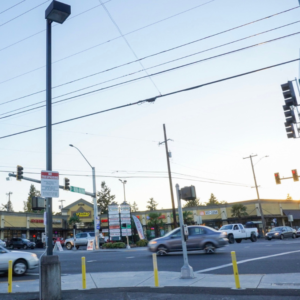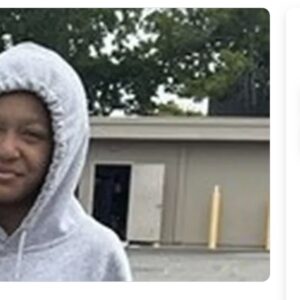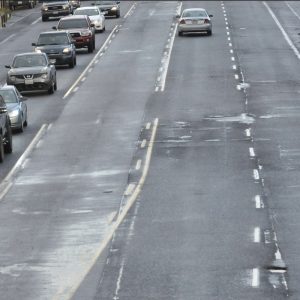
(Photos © J. Maus)
There’s a new piece of paved trail along the east side of the Willamette River between the end of the Esplanade and the beginning of the Springwater Corridor Trail. Unfortunately, the new trail is an island, separated from the existing gap by lots of both sides of it.
The trail was built by the owners of SK Northwest, a major retailer of personal watercrafts and ATVs. Back in 2006, SK Northwest filed for a permit to build on the property at 240 SE Division. Even though there was an existing trail easement along the river through their property, SK Northwest didn’t plan to build it.
The company’s reluctance to build the trail set off major alarms in the community. The issue weaved its way through the Land Use Board of Appeals process, and thanks to significant community outcry, the City denied SK Northwest’s permit. After several appeals that were denied by the City, SK Northwest — facing a trip to the Oregon Supreme Court — ultimately relented in August 2009 and re-filed their permit with a promise to build the trail.
After getting a tip from a reader that their new retail building was nearly complete, I went and checked out the property yesterday.
Sure enough, just beyond SK Northwest’s new parking lot, there’s a new piece of trail…

However, you should contain your excitement, because there’s still a gap between this trail and the southern terminus of the Eastbank Esplanade as well as a gap to the south at Ross Island Sand & Gravel.

That lot to the north is owned by Wayne Kingsley of the Portland Spirit. Mr. Kingsley and Dan Yates, who handles transportation issues for the Central Eastside Industrial Council, have both made it clear that they have no intention of allowing the trail to cross the property. In an interview with Kingsley in April 2006, he cited economic and security concerns as justification for his position.
The new construction at this location isn’t going unnoticed by the neighborhood. The Hosford-Abernethy Neighborhood Association had the issue on their meeting agenda Tuesday night. Land Use Chair Joanne Stainbrook is already looking into the conditions of the company’s development permit to, “follow up on the process and make sure they are fulfilling the original committments.”
In our last report on this story in December 2009, Elly Blue reported that Mr. Yates cites federal maritime security regulations that prevent him from building a publicly accessible trail.
Kurt Krueger with the Portland Bureau of Transportation confirmed that SK Northwest had fulfilled it’s trail building obligation. “We are getting one of the remaining pieces of this project,” he said, “But it won’t make the connection until we see the redevelopment or a City project that moves forward to connect across the Portland Spirit property.”
The conditions of SK Northwest’s permit mandate that this new trail be publicly accessible 24/7. While you can’t actually take it anywhere, you can still ride on it. Go check it out next time you’re in the neighborhood.
CORRECTION: This story was originally published with the wrong name for Wayne Kingsley. I had it as Wayne Krieger. I regret the error and apologize for any confusion.






Thanks for reading.
BikePortland has served this community with independent community journalism since 2005. We rely on subscriptions from readers like you to survive. Your financial support is vital in keeping this valuable resource alive and well.
Please subscribe today to strengthen and expand our work.
So this trail would try to just replace the jog from in front of the Opera building to the Springwater trailhead?
Is that jog so bad? I haven’t found it particularly difficult. Yes it would be optimal to have a trail go next to the river the whole way, but the connection is really not very bad.
Didn’t Trimet just give Krieger $2m recently to compensate for lost business due to bridge construction? I know the issues are not directly related, but it wouldn’t be unreasonable to ask him to allow a 12 foot wide path to cross his property. Is he not part of the neighborhood?
You’re kind of right. It is not related to the bike path at all. The $2M is to offset the cost of having to move and store the boat in a new location. He cannot use his property as he was until Trimet is finished with their bridge – 2014?
You’re forgetting that Krieger doesn’t care about anything but his little boat, and the associated profits.
It’s Kingsley… not Krieger.
So Wayne Krieger is Wayne Kingsley?
No! My mistake. Wrong last name! will fix it immediately. Sorry for confusion (Krieger is the state legislator who wanted bike registration fees).
Here we go with the terrorists on bikes thing again. I can drive up any vehicle I want to the Portland Spirit parking lot and park it there, but I can’t ride my bike next to them? Why don’t we ban bikes in Waterfront Park, too, since the Spirit docks there all the time. lest Next thing you know this guy is going to be wanting an armed Coast Guard escort for the Portland Spirit like the Navy does when they come to town. Never mind that TriMet just gave him $2 million to reconfigure his boat so it’ll fit under the new bridge. The arrogance.
On many occasions I, along with hundreds of other Portland motorists, bicyclists and pedestrians have waited for 5-10minutes at a stretch while the Hawthorne Bridge is raised to allow the Portland Spirit cruise ship to pass underneath the lift span.
From the Mr. Krieger’s history, the intent seems clear: use public resources (bridge operating expense, collective citizen’s time loss) and give back as little as possible. Why allow thousands to use a bike path if you and your attorneys can prevent it? Why not extract million dollar payments from the city if you and your attorneys can force us to? Do the rest of us get compensated for our time loss – collectively we citizens have lost millions as well while sitting for Mr. Krieger’s lifts. The key difference is that he is a millionaire and has resources to ensure that he continues to extract wealth from the rest of us.
Carry on.
Mr. Krieger pays taxes (and probably a lot of taxes given his business location in Multnomah County) so it is his right, just as much as yours, to utilize resources such as bridge operation. I am an avid cyclist, but would be personally opposed to any bike path that the city enforced on a private property owner, especially if he was required to pay for it.
My hunch is that Mr. Kingsley (I mistakenly called him Krieger) bought the property AFTER the trail easement had been created. If so, i think it hurts his argument.
I was wondering about the timeline. It seems to me that if he owned the property before the easement was created, government shouldn’t have the right to mandate it. Of course this would be subject to change as ownership changes.
Also, his arguments in support of global warming (claiming rising water levels will make it so his boat cannot pass under the bridge) seem to conflict with his position against bike transportation on or near his property.
Really?
Even if that property owner bought the property knowing there was an easment on it that required him to do exactly what he does not want to do?
This business location is a matter of practicality; it can’t be good for random drive by sales. It is out of the way in a part of town that most will avoid by car.
A fully installed MUP would allow many MANY more potential customers to see their wares and possibly even purchase some.
Put up a little outdoor coffee/café stand, hock some product, repair PR amongst the cycling community all while simply doing bussiness from a profit minded standpoint.
Get wit` it y’all.
Even good business sense makes an uncomfortable bedfellow to unyielding ideology.
However, its not the city’s place to make that decision for a private business person. If Mr. Krieger wants to build a multi-use pathway himself, that’s fine. If not, too bad.
He (and his neighbor) are running a private businesses on a public river, that we all have to share.
Wayne is sharing the river. I believe he is even sharing his property. What he is not doing is footing the bill for a MUP across his property.
Perhaps the readers of BP could take up a collection and offer to pay for it (and any required B.S. security measures for post 9-11).
Wait would he be open to that? I’d love to help pay for a MUP through there.
Has anyone tried this approach? Probably not. So much easier to just expect someone else to foot the bill. Just look at Congress.
@Mike- I foot the bill for a sidewalk in front of my private property because it butts up against the public right of way and is required by code and ordinance. Why should this private property owner not have to do the same? Private property rights are important, but they are not the end all be all, and sometimes complying with code isn’t free. Welcome to living in a society.
“…What he is not doing is footing the bill for a MUP across his property. …” Mike
Is his main issue, the expense of constructing a MUP across his property? I doubt that’s so. It it were, the story from the beginning would have been Portland Spirit owner Wayne Kingsley requesting help: ‘I would love to build this trail, but I cannot afford to build it on my own.’.
Mr. Kingsley can afford to build that scaffolding like, ugly elevated gangplank down to the river, which everyone across the river strolling or dining on the riverfront probably can’t help but notice, but Kingsley can’t seem to adjust to the idea of building a simple, asphalt paved trail that would allow people to relax and enjoy the east side waterfront.
What’s Kingley’s dream plan that depends upon the bike trail not being there. That’s what I’d like to know. Maybe he has dreams of a big, money making private picnic-wedding-celebration-reception area for the yet undeveloped lot, that would take advantage of the splendid east side riverfront view, and doesn’t like the the idea of a lot of people walking back and forth in front of it. Or something else. Hard to know for sure.
The private business person has public obligations, especially when he controls a limited resource such as waterfront property. This is no different than any other easement issue, most of which involve putting roadways across private land, and which go unnoticed and uncommented on by certain private property rights advocates.
SK Northwest’s new building is good looking. That company, and the nearby Spirit cruise ship operation could be inviting to some of the people passing by on bikes. Locals, probably not so much, but with the trail so accessible to guests at the hotels across the river’s west side…maybe. Except, you can board the cruise ship on the west side. Maybe they’d want to ride over and shop for boats at SK.
I’m curious about who “Christopher” is, and whether he’s employed by any of the interested parties here.
Before you accuse me of being employed by any of the Waynes, I am not. I love riding on the Springwater and would like to see it expanded. But…
I do not believe a government incapable of handling it’s own finanaces should be telling citizens how to handle theirs. Taxes are one thing, but forcing a landowner to install and maintain a MUP when the city can’t even repair its’ own roads? Not cool.
We should scrap building codes and standards too, they just cost more money.
Umm. Yeah. MUP is not equal to building codes. Nice try I guess.
Umm. Yeah. Public right of way and building codes are actually pretty similar in the “why’s’ of their creation. Nice try I guess.
Sidewalks are required by the city and paid for by the land owner. This is no different.
What? PDX’s books are in the black. Nice try, I guess.
As someone who has developed properties in the City of Portland, I am well aware that developers are required to do upgrades to the public right-of-way all the time. The requirement to building this trail is no different. The appeal to some abstract notion of “private property rights” separate from the responsibilities and enormous benefits of owning and developing property in an urban area with all its existing built infrastructure, is more than a little out of place.
I’ll bet a round of beers that the “island” of trail will be used to display the brightly colored watercraft across the river and beyond.
Specifically for Christopher and Mike: The Willamette Greenway is covered by both the state land use plan AND by city ordinance. These property owners don’t get to decide whether they feel like complying or not.
http://www.oregon.gov/LCD/docs/goals/goal15.pdf?ga=t
https://scholarsbank.uoregon.edu/xmlui/bitstream/handle/1794/5689/Portland_Willamette_Greenway_Plan.pdf;jsessionid=4033390A23C9F15EFD953607AAC99C22?sequence=1
Thank you for the links.
A cursory glance did not readily reveal how to handle landowners who obtained the land prior to 1987. Are they grandfathered in to land use regulations prior to this plan?
Does anyone not think it was a huge waste of everyone’s time and resources (private and public sector) to force SK to build the trail without thinking about how they were going to handle the rest of the trail construction?
Perhaps would it not have been better to keep the easements in the back pocket until the properties without easements were compelled to participate?
Did SK spend considerable money to build a trail that will never be used until the other property owners comply?
Doesn’t that seem foolish?
Can this process take years? Indeed, it did with SK.
So by the time there is a link to the island trail, that nice path will be a cracked weed strewn piece of asphalt.
What a waste.
The trail to nowhere.
about as foolish as the half-block bike lane on 52nd just south of Foster… sure it looks stupid now, but it’s needed for the future when other lanes will be built to connect to it…
can’t expect everybody to hold off on building their part until everybody is ready at the same time… if that happened then nothing would get built…
Actually, this is how trails and really networks of anything are built. It’s nice to think we just roll it all out at once, but that’s just not how it works, especially the way funding is cobbled together over time.
Nice to hear we are getting closer to our long-term goal of connecting the trailways here.
Meh… the trails are already connected by about 3-blocks of low-traffic, wide, flat road. I personally don’t care if the trails are “connected” by a path or not.
it won’t be low traffic anymore when the new MLK viaduct is finally completed and fully functional, and each new business like SK NW brings in additional traffic…
Moody will soon be a Max & Streetcar bridge ramp. Have fun biking across 4+ sets of rail tracks AND a rail intersection.
My only point on this is profit: by increasing customers he increases profit.
Easement or not his customers have limited access to this site. It is convienient by no way other than water.
Fact is though that it is almost capable of being in the perfect location on Portland’s busiest an active transport corridor.
For every penniless transient the are 10~100 people zipping by with the sort of disposible income they are currently spending on Unobtainium frames.
Every easement is a compromise between private property rights and public access rights. In this compromise, SK Northwest could stand to make many more sales and increase its public image.
If access really matters to you, then voice your concerns at a nice and public venue like the Portland Waterfront by the fountain where the Spirit just happens to pick up all their customers. Oh the shame, oh the specticle, oh the blocking of access. It is public space. Do this regularly and affect the bottom line, and then you might see him relenting on his policy of denial of access.
Ignoring the spirit issue….
The photo shows a really crappy trail. Really thin layer of ugly asphalt, and nothing around it. A remarkably cheap job. No lights, not concrete, no plants…
Not surprised. How dare we expect a private developer to build a public amenity that actually benefits their business as condition for their expansion which has adverse effects (traffic etc). How dare we.
Talk about NOT having the “Portland spirit!” After feeding at the public trough, these owners should step up and do the right thing or leave town.
My sentiments exactly.
Jonathan,
Your statement that there was “an existing trail easement along the river through [the SK] property” is incorrect. The City Zoning Map designated the property for a greenway trail, but there was no “easement” until SK Northwest granted the City the easement. In other words, the public doesn’t obtain a right to cross private property simply because the zoning map has a trail designation. The trail designation demonstrates the City is planning to have a trail, not that it has a legal easement.
exactly! It seems like the standard for this trail should be equivalent to the standard for the Eastside Esplanade – concrete plus amenities like lighting, plantings and benches – and not the equivalent of the crappy interim asphalt that is present between the Hawthorne Bridge and OMSI.
Asphalt is what was required. The City had the alternative of accepting money from SK, and building its own (concrete?) trail, but didn’t exercise that option. Extensive landscaping will be done after construction.
http://www.portlandonline.com/bds/index.cfm?a=205548&c=49783
A boycott could be organized of the Portland Spirit & its associated businesses if a trail is the end goal. There are many bicyclists in all areas of business in our city. If the word were spread, it could be done.
You can say that again!
This brings up what seems to be a huge area of funding inequity in transportation: For roads, we generally use public funds for construction. For sidewalks and easement MUPs, we often rely on extracting money from the property owners. No wonder sidewalks and easement MUPs don’t always get built where and when they should.
Let’s not forget that just 200 years ago if you were to mention the concept of “ownership” of land to the denizens of this area, they would have thought you a fool.
And let’s not forget that 2000 year ago if someone had seen you ride around on a bicycle in this area they would have though you were a supernatural being!
And let’s not forget that 200,000 years ago the Portland Spirit wouldn’t have been able to dock on the river at all because this wasn’t a river valley!
Actually, it probably was. The fluvial (e.g. riverine/riparian) geologic depositional environment in the Portland basin has existed since at least the early Pliocene, or about 5 million years ago.
http://vulcan.wr.usgs.gov/Volcanoes/Oregon/Publications/Bulletin1119/geologic_history.html
Why didn’t TriMet use its mitigation dollars to buy out the Portland Spirit property and relocate the business?
Tri-Met is paying $4 million to compensate them for the trouble, but it also assures that they stay put and not build the trail. $2M for a temp construction easement, $1.5M to rebuild their dock, and $.5M to modify boats. Market value of the property is ~$2M. Seems like buy-and-relocate would have given Kingsley a good return, cleared the way for bridge construction, and filled in the trail gap. I have a hard time believing no other relocation site exists, especially with some extra money in his pocket and in a down real estate market.
Oh, well. Too late now. We’ll get that trail connection in another 50 years or so.
http://www.portlandtribune.com/news/story.php?story_id=130998907495075400
http://www.portlandmaps.com/detail.cfm?action=Assessor&propertyid=R275775&state_id=1S1E03DD%20%20800&address_id=1074960&intersection_id=&dynamic_point=0&x=7647431.104&y=677747.673&place=250%20SE%20CARUTHERS%20ST&city=PORTLAND&neighborhood=HOSFORD-ABERNETHY&seg_id=185166
I think property would be easy to find, but putting in a dock and getting rights to do so for 3 substantially sized ships near the downtown area could be almost impossible. Without that they would probably lose their business, which in turn is a hit to the Portland area economy. It’s pretty common for projects like this to compensate adjacent landowners and businesses and $4 million is not a lot. Trimet was complacent about these issues and the light bulb didn’t turn on until the last minute which probably cost them a lot more money. They’ve even had to redesign the bridge because they didn’t make it high enough to accommodate some of the larger river traffic during high water seasons. They could have mitigated these issues during the planning stage and probably saved themselves and taxpayers a lot of money.
They are taking out the existing dock, and need to get all these permits to build the new one anyway. There would not be much difference in permitting between doing it here versus at a similar site.
It is reasonable to compensate owners for their trouble, but at a certain point, buying them out makes more economic sense. It seems to me that threshold is less than $4M.
What if TriMet had made paying for the fancy new $1.5M dock contingent on a trail easement? That would get everyone what they want, it seems: new dock and short-term compensation for Kingsley, use during construction for TriMet, trail segment for the City.
time for the city to step up and threaten eminent domain on the trail in a way that makes it impossible for them to access the river for loading, giving them only one other option which is to immediately build the trail.
they are still loading boats at the property, even though construction has started and July 1 has come and gone.
To clarify, suitable locations were looked at for the potential relocation of Portland Spirit. Criteria included
• having waterfront access with landside facilities (storage/loading and maintenance ability)
• being upstream from the Steel Bridge (lower deck openings)
• being located within a short distance from the Salmon Street Springs dock
• and avoidance of interference with the greenway on either bank of the river
Ultimately, however, two potential locations were eliminated due to environmental land use or greenway issues.
John Fall, Community Affairs
TriMet Capital Projects
You got at least five things wrong. I will be happy to point them on when I get back to white Portland on august 8. Should I call you
How is this easement all that different than one for a sidewalk? Individuals and businesses run into the same thing with sidewalks and they have to build them – at a much greater expense than this bike path, I might add. Laying out and such of the asphalt is much cheaper than concrete and curbs.